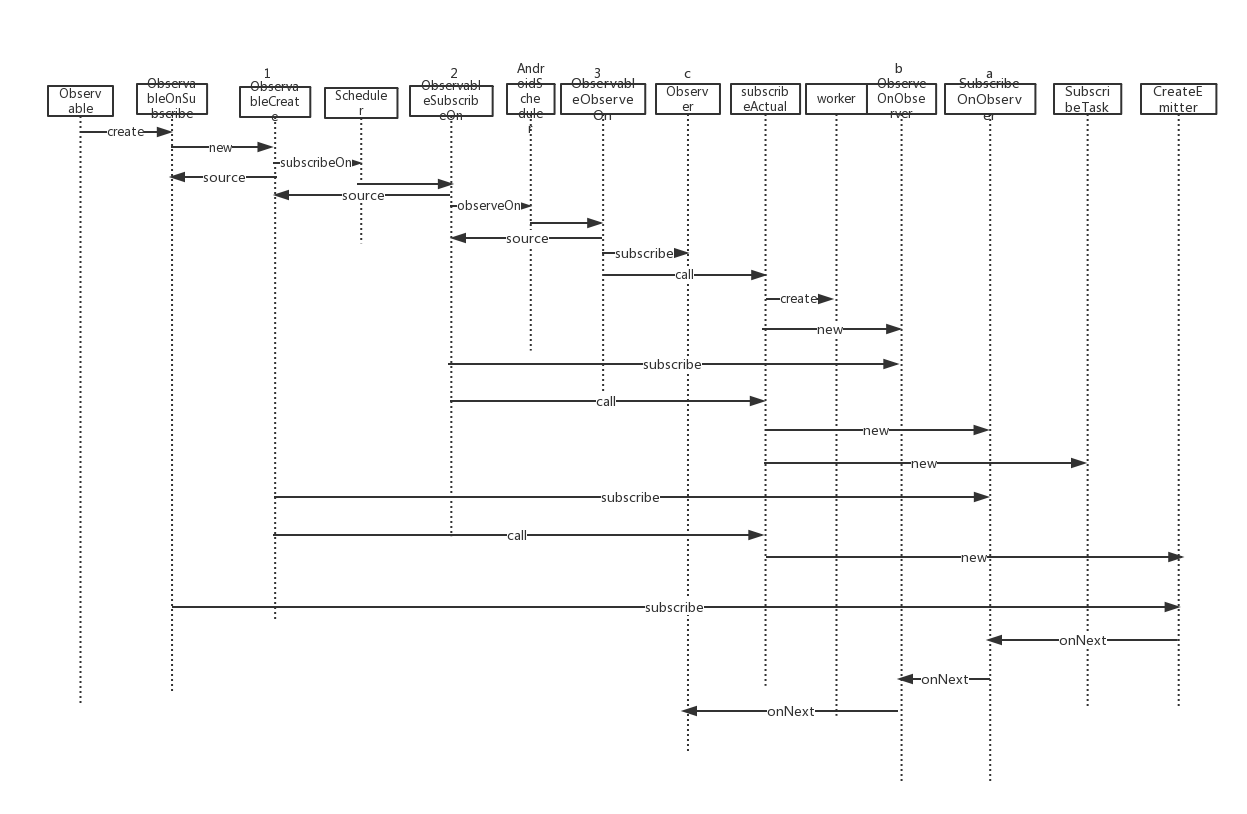This time we are talking about the thread switching process of RxJava. First, look at a diagram: 
The RxJava code for this time series diagram:
public void demo2(){
createObservable()
.subscribeOn(Schedulers.newThread())//Observed executes subscribe on a new thread
.observeOn(AndroidSchedulers.mainThread())//The observer executes onNext onComplete on the main thread
.subscribe(createObserver());
} //Create an observer
private Observer createObserver() {
return new Observer() {
@Override
public void onSubscribe(Disposable d) {
printThreadId("onSubscribe");
}
@Override
public void onNext(Object o) {
printThreadId("onNext" + o);
}
@Override
public void onError(Throwable e) {
printThreadId("onError" + e.getMessage());
}
@Override
public void onComplete() {
printThreadId("onComplete");
}
};
}
//Create Observed
private Observable createObservable() {
return Observable.create(new ObservableOnSubscribe() {
@Override
public void subscribe(ObservableEmitter e) throws Exception {
printThreadId("subscribe");
e.onNext(1);
e.onComplete();
}
});
}Execution results:
/**
12-06 15:34:35.577 27544-27544/com.study.rxjavademo I/ThreadDemos: onSubscribe thread_name: main
12-06 15:34:35.587 27544-27608/com.study.rxjavademo I/ThreadDemos: subscribe thread_name: RxNewThreadScheduler-1
12-06 15:34:35.627 27544-27544/com.study.rxjavademo I/ThreadDemos: onNext1 thread_name: main
12-06 15:34:35.627 27544-27544/com.study.rxjavademo I/ThreadDemos: onComplete thread_name: main
*/What does the code above mean?
We can simulate a network request with the above code:
1. The observee is a network request
//Create Observed
private Observable createObservable() {
return Observable.create(new ObservableOnSubscribe() {
@Override
public void subscribe(ObservableEmitter e) throws Exception {
printThreadId("subscribe");
e.onNext(1);
e.onComplete();
}
});
}The subscribe method performs a time-consuming operation, so we should let it execute on a non-primary thread.
2. The observer is equivalent to a callback waiting for the network to return
//Create an observer
private Observer createObserver() {
return new Observer() {
@Override
public void onSubscribe(Disposable d) {
printThreadId("onSubscribe");
}
@Override
public void onNext(Object o) {
printThreadId("onNext" + o);
}
@Override
public void onError(Throwable e) {
printThreadId("onError" + e.getMessage());
}
@Override
public void onComplete() {
printThreadId("onComplete");
}
};
}We want some ui adjustments on onNext returns, so we should set it on the main thread.
3. How do I set it on which thread?
.subscribeOn(Schedulers.newThread())//Observed executes subscribe on a new thread
.observeOn(AndroidSchedulers.mainThread())//The observer executes onNext onComplete on the main threadNow there are scenes and results.So how do these work in RxJava?
Next, the source code for the entire process is analyzed.